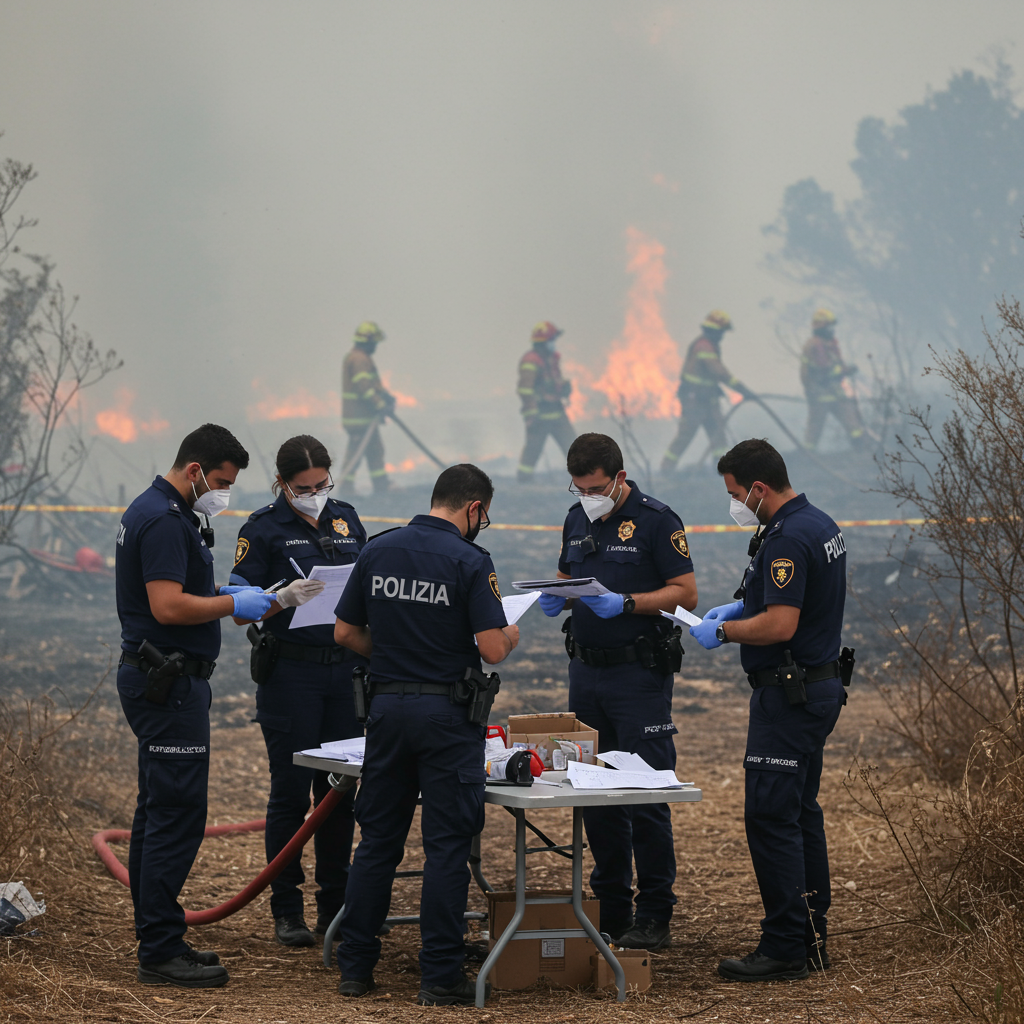extreme temperatures gripping Europe have fueled deadly wildfires, with a tragic incident in <a href="https://news.quantosei.com/2025/07/02/scorching-european-heatwave-turns-deadly-in-spain-italy-and-france/” title=”Deadly Heatwave Sweeps Europe: Lives Lost Amid 40C+ Temps”>catalonia, Spain, leading to a police investigation into two fatalities. Authorities are probing the deaths of two farm workers discovered by firefighters battling a fierce blaze in Lleida province. The incident underscores the growing danger of wildfires in a changing climate and highlights the widespread impact of the intense heatwave affecting multiple countries across the continent.
Deadly Wildfire Claims Two Lives in Lleida Province
Catalan police, the Mossos d’Esquadra, have opened an investigation following the discovery of two bodies during a wildfire operation near the town of Coscó in Lleida province. Firefighters found the victims on Tuesday while working to control the blaze. According to Catalonia’s interior minister, Núria Parlon, the deceased were farm workers. They were tragically caught by the rapidly advancing flames as they attempted to reach their vehicles, likely seeking escape from the inferno that ignited on July 1, 2025, near Torrefeta i Florejacs.
The fire, which burned approximately 6,500 hectares (about 16,000 acres) primarily across agricultural land and rural properties, exhibited alarming behavior. The regional fire department described the blaze as showing “extremely violent and erratic behaviour.” This intensity was influenced by nearby storms, though the eventual arrival of rain helped crews bring the situation under control by Wednesday morning. The fire started from two points that quickly merged, demonstrating significant power from the outset.
Investigating the Ignition and Extreme Behavior
Police are specifically investigating the cause of the fire’s ignition. Early indications suggest the blaze may have started accidentally, possibly linked to agricultural machinery operating under hot, dry conditions. Lightning has been ruled out as a potential cause.
Firefighters noted exceptionally high flame propagation speeds during the height of the incident, reporting rates up to 28 km/h (about 17 mph). The fire also produced a remarkably tall convection column, reaching heights estimated between 14 km (45,900 feet) and potentially 19 km (62,300 feet). This scale is noted as one of the tallest plumes ever recorded in the region, indicating the immense energy and volatile nature of the fire. The blaze generated its own winds and formed pyrocumulus clouds, further complicating suppression efforts.
Confinement Orders and Firefighter Safety
At the peak of the emergency, authorities issued a confinement order for around 20,000 residents across nine municipalities in the affected area to ensure public safety. This order remained in place until late on July 1 when evening rain helped reduce fire activity, allowing it to be lifted.
Fire suppression involved over 130 personnel, supported by more than 40 vehicles and 4 aerial units. However, the fire’s erratic behavior, fueled by extreme conditions, forced a shift in strategy. Firefighters prioritized perimeter defense and their own safety due to the unpredictable nature of the flames. One firefighter sustained minor injuries from collapsing debris during the operation, highlighting the risks involved.
Europe Grapples with Widespread Extreme Heat
The deadly Catalonia wildfire is not an isolated event but occurred within the context of a severe and prolonged heatwave sweeping across much of Europe. Countries from Spain and Italy to France, Germany, and Poland are experiencing unprecedented high temperatures, leading to numerous challenges beyond wildfires. This period marks a significant increase in extreme weather events across the continent.
The heatwave has been linked to additional fatalities across Spain and Italy. Spain recorded another heat-related death in the Extremadura region. In Italy, at least three deaths were connected to the heatwave, including a lorry driver and a construction worker who collapsed. These incidents underscore the direct health risks posed by prolonged exposure to extreme heat, prompting warnings and calls for protective measures, particularly for outdoor workers. Italy has even introduced limits on outdoor work during the hottest hours.
Strain on Agriculture and Infrastructure
The impact of the heatwave extends significantly to the agricultural sector. Farmers across Europe are reporting widespread damage. In Italy, for example, Coldiretti, a major farmers’ association, detailed scorching of crops like melons, drops in milk production (up to 15% in Lombardy), and accelerated ripening of grains and grapes. Farmers are implementing measures like cooling systems for livestock and protective netting for fruit, while also battling increased pest infestations exacerbated by the heat. Water rationing is occurring in drought-stricken regions like Sicily, with national reservoir levels worryingly low, impacting irrigation and animal farming.
Infrastructure is also under pressure. Power cuts have been reported in various Italian cities, including Florence, Milan, Rome, and Bergamo. This is attributed to the heavy strain on the electricity grid from non-stop air conditioning use and overheating cables. These outages have caused disruption, from failing traffic lights to people trapped in lifts.
Warnings: Fires Are Different Now
Regional leaders and fire services have issued urgent warnings about the nature of current wildfires. Salvador Illa, Catalonia’s president, echoed concerns about the speed and intensity of these blazes. “These fires aren’t like the ones we used to have,” he stated, highlighting a significant change in how they behave and spread. He described the evolution of these fires as “really dangerous,” causing “goosebumps” when understood.
The fire service reinforced this message, emphasizing the rapid spread. They warned that even if a column of smoke or fire seems distant, there is little time to react. The arrival of forecast storms might even complicate extinguishing efforts due to erratic winds, although rain can ultimately help containment. Regional president Salvador Illa described the Torrefeta i Florejacs incident as among the most extreme recent wildfires in Catalonia, starkly illustrating the new reality of fire risk.
Adapting to a Hotter Climate: Policy and Innovation
The recurring and intense heatwaves are pushing discussions on climate adaptation to the forefront. While efforts continue to mitigate climate change through emissions reductions, the immediate need to adapt to current conditions is becoming increasingly clear.
The European Commission recently proposed a legally binding target to cut greenhouse gas emissions by 90% by 2040 compared to 1990 levels. While a significant step, it falls short of the higher range recommended by scientific advisors and includes controversial provisions for using foreign carbon credits, drawing criticism from green groups who fear reliance on ineffective offsets. The EU’s climate commissioner acknowledged the political challenges in gaining national support for ambitious targets.
Amidst the heat, adaptation strategies are debated. In France, extreme heat sparked political discussion around the role of air conditioning. While some propose widespread installation as a safety measure, others argue it is not a sustainable solution, increases outdoor temperatures, and that focus should be on building insulation and urban green spaces. France currently has lower AC usage in homes compared to countries like Italy, though usage is rising, particularly in southern regions.
Innovative adaptation measures are also under development. Researchers are exploring AI-engineered paints designed to keep buildings significantly cooler – potentially 5C to 20C below normal paint temperature. This technology aims to reduce the urban heat island effect and decrease reliance on energy-intensive air conditioning. Widespread application of such paints could lead to substantial electricity savings.
Economic Impact and the “Silent Killer”
Beyond immediate dangers and environmental damage, extreme heat events carry significant economic costs. A report by Allianz Research projected that recent heatwaves could slow overall European economic growth by half a percentage point in 2025. Specific countries like Spain, Italy, and Greece could face GDP losses approaching one percentage point.
The widespread impacts – from fatalities and infrastructure strain to agricultural losses and economic slowdowns – paint a picture of the profound challenges posed by extreme heat. The phenomenon is increasingly being referred to as a “silent killer,” particularly given its disproportionate impact on vulnerable populations. Addressing both mitigation and adaptation is crucial as Europe navigates a future with more frequent and intense heat events.
Frequently Asked Questions
How did the deadly Catalonia wildfire start, and how did it spread so fast?
While the exact cause is still under police investigation, early indications suggest the fire likely originated accidentally, potentially linked to agricultural machinery. The fire ignited from two points that quickly merged. Its rapid and extreme spread, with flame propagation speeds up to 28 km/h (17 mph), was fueled by critical weather conditions including high temperatures (around 39°C), low humidity, strong winds, and the wider heatwave context. The blaze generated its own complex dynamics, including convection-induced winds and a remarkably tall smoke plume, contributing to its erratic and violent behavior.
Who is investigating the deaths in the Lleida wildfire?
The deaths of the two farm workers found near Coscó in Lleida province, Catalonia, are being investigated by Catalonia’s regional police force, the Mossos d’Esquadra. They are working to determine the circumstances surrounding the fatalities, including how the victims became trapped by the flames, and are also investigating the original cause of the wildfire’s ignition.
What makes these recent wildfires in Europe, like the one in Catalonia, so dangerous compared to past fires?
Regional authorities and fire experts highlight that recent wildfires exhibit significantly different and more dangerous behavior than those historically experienced. These fires are characterized by extremely rapid spread, intense heat, and erratic behavior often influenced by changing weather conditions and their own generated wind patterns. As Catalonia’s president noted, they “aren’t like the ones we used to have” and can move far faster than people realize, reducing evacuation time and complicating suppression efforts for firefighters. The scale and speed of spread under heatwave conditions create unprecedented challenges.




